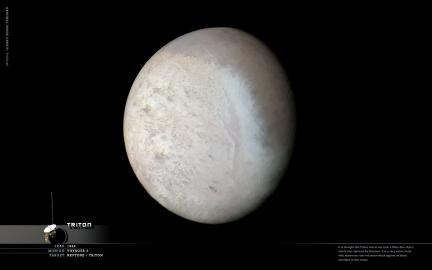 Another big surprise of the Voyager mission was the discovery that the coldest place in the solar system is also home to a considerable amount of geological activity. The moon appears to be widely populated by a large amount of cryovolcanos which were observed directly by Voyager in 1989. These volcanos can be seen in this image as small black smudges mostly located running across the center of the disk. It also has a tenuous atmosphere almost entirely composed of nitrogen.
Another big surprise of the Voyager mission was the discovery that the coldest place in the solar system is also home to a considerable amount of geological activity. The moon appears to be widely populated by a large amount of cryovolcanos which were observed directly by Voyager in 1989. These volcanos can be seen in this image as small black smudges mostly located running across the center of the disk. It also has a tenuous atmosphere almost entirely composed of nitrogen.
One of the most interesting bits of information about Triton to me is that the orbit runs in the opposite direction of Neptune’s rotation. This suggests that at one time, Triton may have been a dwarf planet captured by Neptune’s pull. This would also explain the lack of numerous moons which we see at many of the other gas giant planets. Triton would have swept through the Neptune system and probably either collided with or ejected whatever moons may have existed in the system. Triton also has a very slowly decaying orbit and will likely collide with Neptune or shatter into pieces to form a new ring system in 3.6 billion years.
Image Note: This is the orignal Triton portrait image that was posted to this site. The newer and improved main top image was recently generated by Ted Stryk and posted to unmannedspaceflight.com.
